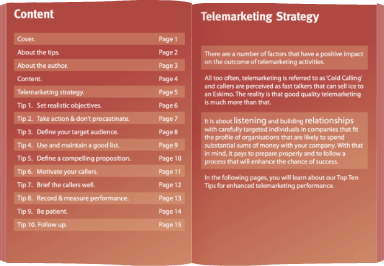If you’re using telemarketing to generate sales leads, you want your team to perform, right? Are they delivering the number of enquiries or sales you need to oil the wheels of growth? If not, maybe you need to think first about the input rather than the output. Of course, it’s essential to have telemarketers that are willing to get on the phone in the first place, that have energy and motivation and that make enough calls to make a difference. But let’s imagine those boxes are ticked but it’s still not working. What could be wrong?
In reality, there are all manner of circumstances and issues that could derail your new business development exercise. In this article, we’ve detailed a few of the inputs you might want to look at that enhance or impede telemarketing lead generation and we show you how to get better results from telemarketing activity. Don’t forget to check out our videos for top tips and our infographic on the 10 Cardinal Sins of B2B Cold Calling.
Systems for Success
What system does your team use to make calls? There are lots of good CRM solutions out there. I recently visited a client where all 4 callers used different approaches. One used excel. Another used their CRM. The third uses a hard copy list and a pad. The fourth used Hubspot. A nightmare from a long-term and consistent lead generation perspective.
In terms of the system you use, is it configured for telemarketing workflow? Is it easy to navigate? Can the team simply prioritise their important calls for each day and find them quickly? Are all the relevant tabs and information in the right place? A CRM that is properly structured for telemarketing use, as opposed to being set up for broader marketing, can make up to a 50% difference in the number of calls made each day. It also reduces telemarketer frustration. So make sure your team aren’t using excel or pen and paper and ensure your CRM is fit for purpose.
Data Disasters
The reality is that it’s impossible to keep b2b data clean unless you undertake constant data validation. That’s due to the fact that there are so many personnel and organisational changes each year. Poor data is the single most damaging element in failing telemarketing lead generation. With inaccurate data, there’s a higher probability of being blocked by no name policies (albeit there’s less of an excuse nowadays with LinkedIn). You can also make 10 calls to a company to reach John Smith only to find it isn’t him that deals with your area of interest and you need to start over again. That significantly increases wastage and the potential ROI from calling.
We’ve had campaigns where our callers have received data from a client and circa 80% were wrong numbers and /or wrong person. This impeded results and slowed us down tremendously. It isn’t always easy especially where your target decision maker job function isn’t run of the mill and commonly found on broker lists. In those cases, you may need to data build to generate a good quality target list. Ultimately, you need to recognise that if you want your team to deliver results fast, you need to provide them with clean data and that means right numbers and the right people to call.
Briefing or Lack of…
In the past, we’ve spoken to callers whose briefing is non-existent in advance of the calling campaign. They’ve simply been given a database and told to drum up some business. Why would a prospect use your business versus a competitor? How entrenched with incumbent suppliers might the companies be that they’re calling? What challenges do prospects have that you can resolve? What objections might callers run into? These are just a few of the crucial briefing points you should provide in advance of calling. The better prepared the callers are, the more traction they will achieve.
Get the Environment Right
What’s the environment for calling? Are callers stuck in a dark room at the end of the corridor? Sales lead generation is a tough job and telemarketing is probably at the top of that profession in terms of difficulty and, to some extent, monotony. So, make sure your callers are comfortable. They need space to spread out if they have accompanying info for a campaign. Get them a headset and a comfy chair. Make sure they have wide screen monitors. It may sound simple and maybe it’s what you do for everyone. But, sitting at a desk all day bashing out calls is a thankless task. So, be sure you provide the physical tools they need to do a good job.
Positive motivation
Along with the tools to do the job comes motivation. It’s a slog at times. Therefore, motivation and incentivisation play a role. That doesn’t always mean money. Positive feedback is essential. A vote of thanks for a good appointment or order goes down well. Doughnuts or chocolate for a particularly good week. Or the possibility to leave an hour early for a good result day can all add to the desire to perform. And ,of course you can’t forget commission on achievement as long as the targets are stretching but attainable.
Training for Better Results
Training takes two parts. First, have your team got the requisite skills and techniques to do the job? If you’re unsure, put them on a telemarketing skills training course. It’ll pay dividends. Not all telemarketing is intuitive. It isn’t just about the art of talking. Listening, questioning and rapport building are essential skills that can be learned. Likewise for gatekeeper techniques and objection handling.
But it’s not just about up front training. Most training fails if it isn’t embedded through use. And you learn what works and what doesn’t throughout a telemarketing campaign. So, it’s about on the job continuous improvement. It’s identifying the typical objections and blocks on a given activity. Plan for these. Work out the responses. Test and measure. If you have a successful caller, ask them to sit for a morning with those less successful and make it worth their while. Make on the job training and continuous improvement part of the process and you’ll generate better results.
Benchmarking
We recently won two new clients where they’d undertaken telemarketing in the past and knew broadly what results they were likely to achieve. They had benchmarks from other countries and from their internal UK calling. Having targets is essential and a telemarketer need to know they’re realistic. Having a benchmark upon which to base sales goals is important especially if they’re proven.
Equally, you can benchmark over time once you’ve called through sufficient data to assess list quality, typical responses and so on. If you’ve got several callers, you can benchmark their performance over time and this encourages competition. Telemarketing benchmarking provides evidence of success, a clear goal and motivation to achieve.
If you’d like to know how GSA Business Development can help generate growth for your business through telemarketing or social media lead generation or you’d like to book one of our new business development and marketing strategy workshops, contact us now on 0845 658 8192 or use the form on this site.






